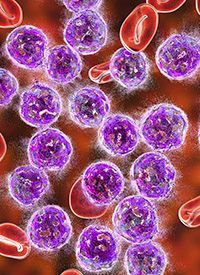Article
PRO Results Show Zanubrutinib Improves HRQOL Vs Ibrutinib in R/R CLL/SLL
Author(s):
Patients with relapsed/refractory chronic lymphocytic leukemia or small lymphocytic leukemia assigned to zanubrutinib reported better health-related quality of life than those administered ibrutinib.
Chronic Lymphocytic Leukemia

Patients with relapsed/refractory (R/R) chronic lymphocytic leukemia (CLL) or small lymphocytic leukemia (SLL) assigned to zanubrutinib (Brukinsa) reported better health-related quality of life (HRQOL) than those administered ibrutinib (Imbruvica), according to findings from the phase 3 ALPINE trial (NCT03734016).1
Investigators presented data from cycles 7 (6 months) and 13 (12 months) of treatment in a poster the during the 2022 EHA Congress. They evaluated HRQOL using patient-reported outcomes (PRO) assessed by the EORTC QLQ-C30 questionnaire and EQ-5D-5L descriptive system at baseline, Cycle 1, and then every third cycle until end of treatment.
Key PRO endpoints included global health status (GHS), physical and role functions, and fatigue, pain, diarrhea, and nausea/vomiting. Investigators used a mixed model repeated-measure (MMRM) analysis of the longitudinal QLQ-C30 data to conduct descriptive analysis on all scales.
At cycle 7, the mean change in baseline GHS was greater for patients assigned to zanubrutinib (8.55; 95% CI, 6.36-10.74) compared with ibrutinib (5.10; 95% CI, 2.82-7.37). Investigators also observed greater improvements in the zanubrutinib arm for physical functioning (7.16 vs 4.53), and role functioning (7.44 vs 6.46).
Zanubrutinib was associated with greater improvements in the mean change from baseline for diarrhea (-2.37 vs -1.12), fatigue (-13.09 vs -10.14), nausea/vomiting (-1.66 vs -0.53), and pain (-5.23 vs -4.03) by cycle 7.
Investigators wrote that the improvements in HRQOL were greatest in cycle 7, suggesting that zanubrutinib may relieve disease burden in this patient cohort earlier than ibrutinib.
ALPINE is an international, open-label study comparing the BTK inhibitor zanubrutinib vs ibrutinib for safety, efficacy, and HRQOL. A total of 327 patients were randomly assigned to 160 mg of oral zanubrutinib twice per day (n =327) or 420 mg of ibrutinib once per day (n = 325).
In interim results presented at the 2021 International Workshop on CLL, the overall response rate (ORR) was 78.3% in the experimental arm compared with 62.5% in the control arm.2
Twelve-month progression-free survival (PFS) favored zanubrutinib, 94.9% vs 84.0% (HR, 0.40; 95% CI, 0.23-0.69; P = .0007). Overall survival (OS) at 12 months was also superior in the experimental arm (97.0% vs 92.7%; HR, 0.54; 95% CI, 0.25-1.16; P = .1081).
Regarding patient characteristics, median age (67 years vs 68 years), race, sex (65.1% male vs 71.4% male), ECOG performance status (96.9% 0 or 1), disease history, and genetic mutations were similar between the zanubrutinib and ibrutinib arms.
At cycle 13, zanubrutinib remained superior for GHS, plus mean change from baseline in physical functioning (6.93 vs 5.70) and role functioning (8.05 vs 6.00). Investigators also observed greater improvements in the experimental arm for diarrhea (-4.29 vs -1.79) and pain (-5.17 vs -3.29).
However, zanubrutinib was comparable to ibrutinib for fatigue (-12.48 vs -12.08) and nausea/vomiting (-0.95 vs -0.43), respectively, at cycle 13.
Mean change from baseline as assessed by the EuroQol-visual analogue scales was superior for zanubrutinib at cycle 7 (8.4 vs 4.0) and at cycle 13 (6.8 vs 5.2).
Zanubrutinib is currently FDA approved in the United States for mantle cell lymphoma, marginal zone lymphoma, and Waldenstrom macroglobulinemia. In February 2022, the FDA accepted a supplemental new drug application for zanubrutinib in this indication based on findings from ALPINE and the phase 3 SEQUOIA study (NCT03336333) of zanubrutinib vs bendamustine plus rituximab (Rituxan) for the treatment of treatment-naïve patients with CLL.3
In SEQUOIA, the ORR was 94.6% (95% CI, 91.0%-97.1%) with zanubrutinib compared with 85.3% (95% CI, 80.1%-89.5%) with bendamustine plus rituximab. Further, 6.6% of patients in the experimental arm had complete responses compared with 15.1% of the bendamustine/rituximab arm.4
The estimated OS rate with zanubrutinib in SEQUOIA was 94.6% compared with 85.3% in the control arm. Improvement with PFS was also statistically significant for the zanubrutinib arm compared with the bendamustine/rituximab arm (HR, 0.42; 95% CI, 0.28-0.63; 1-sided and 2-sided P < .0001). The estimated PFS at 24 months was 85.5% in the zanubrutinib group vs 69.5% in the control group.
References
- Hillmen P. Health-related quality of life outcomes associated with zanubrutinib vs ibrutinib monotherapy in patients with relapsed/refractory (RR) CLL/SLL: results from the randomized phase 3 ALPINE trial. Presented at: 2022 European Hematologic Association Congress; June 9-12, 2022; Vienna, Austria. Poster 663
- Hillmen P, Eichorst B, Brown JR, et al. First interim analysis of ALPINE study: results of phase 3 randomized study of zanubrutinib vs ibrutinib in patients with relapsed/refractory chronic lymphocytic leukemia/small lymphocytic lymphoma. Presented at: 2021 International Workshop on CLL; September 17-20; virtual. Accessed June 9, 2022. https://bit.ly/39mW4an
- BeiGene announces U.S. FDA acceptance of supplemental new drug application for Brukinsa (zanubrutinib) in chronic lymphocytic leukemia. News release. BeiGene. February 22, 2022. Accessed June 9, 2022. https://bit.ly/3MFgKbc
- Tam CS, Giannopoulos K, Jurczak W, et al. 396 SEQUOIA: results of a phase 3 randomized study of zanubrutinib versus bendamustine + rituximab (BR) in patients with treatment-naïve (TN) chronic lymphocytic leukemia/small lymphocytic lymphoma (CLL/SLL). Blood. 2021;138(suppl 1;396. doi: 10.1182/blood-2021-148457









